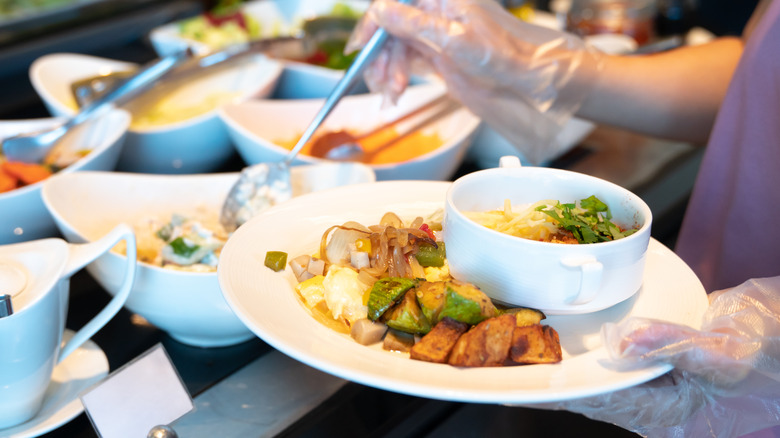Why You Need To Consider Food Safety Before Hitting Up A Buffet
The all-you-can-eat buffet is the dining guilty pleasure that no one wants to admit they enjoy. We see you. We get you. It's hard to resist the allure of paying a flat rate for multiple plates. At a buffet, you're not tied down to a menu or stuck waiting on your server. Instead, you're allowed to roam free to create your own combination of foods and return as many times as your stomach can handle. However, despite the hunger-fueled freedom, there are certain health concerns you want to consider before hitting up the buffet.
Foodborne illness and improper handling of food go hand-in-hand. According to the CDC, it is estimated that 1 in 6 Americans (around 48 million people) get sick from foodborne related pathogens each year. This category includes the 31 pathogens known to the CDC and a variety of unknown or unspecified agents. So if buffet food isn't properly handled, it can become a breeding ground for the exact pathogens that cause so many Americans to get sick. Bearing that in mind, there are a few things that you can do or observe to reduce your risk of food poisoning from a buffet.
Food buffet safety precautions
When at a buffet, we're presented with a bevy of foods that can be overwhelming to choose from. Aside from ensuring that the buffet is tidy, clean, and has attentive waitstaff, the types of food you're presented with do not always lend themselves to buffet-style serving. According to Insider, the temperature at which the food is kept is vitally important. The "danger zone" is between 40 to 140 degrees Fahrenheit, the temperatures at which bacteria can thrive. If your food is meant to be cold, make sure it's being served on a bed of ice. Likewise, if your food is supposed to be hot, make sure the tray is filled with a steaming hot water bath or another proper heat source.
Another critical point to remember is the CDC's two-hour rule about perishable foods being left out. If perishables have been left at room temperature for more than two hours, bacteria have likely made a home there, and the food should be disposed of. The Healthy also states that cream-based foods, like pasta Alfredo, sprouts, sushi, mayonnaise-based dishes, salad dressings, and sweetened drinks, are also items to be wary of. Also, make sure your fellow diners are handling the food properly. If they are dipping serving utensils — or using their hands — in multiple food trays, the potential for cross-contamination increases dramatically.

